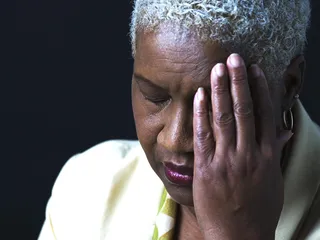The 411 on African-Americans and Breast Cancer
A look at breast cancer’s impact on the Black community.

1 / 17
Get the Facts - Breast cancer is the second most commonly diagnosed cancer among African-American women. And Black women are more likely to die from the disease than any other racial or ethnic group, according to the American Cancer Society. Keep reading to see the full scope of breast cancer in the Black community and learn how you can protect yourself. –Britt Middleton (Photo: American Cancer Society)

2 / 17
New Cases - In 2011, 26,840 new cases of breast cancer were estimated to occur among African-American women (Source: American Cancer Society) (Photo: David McNew/Getty Images)

3 / 17
Trends in Breast Cancer Incidence - Between 2003 and 2007, the average yearly breast cancer incidence rate in Black women was 114.7 cases per 100,000 women, which was 6 percent lower than in white women. However, in women aged 45 or younger, incidence rates were higher among African-Americans than whites. (Source: American Cancer Society) (Photo: Chicago Tribune/MCT /Landov).

4 / 17
The Root Cause - Scientists have not discovered a definitive cause for cancer, but genetics, aging and exposure to hormones to treat menopause symptoms are factors known to increase a woman's risk of developing breast cancer. (Source: American Cancer Society) (Photo: PA Photos /Landov)

5 / 17
Increased Risk - Premenopausal African-American women are at a higher risk for developing basal-like breast cancer, a more aggressive form of the disease that’s associated with a shorter survival rate. (Source: American Cancer Society) (Photo: Chris Hondros/Getty Images)
ADVERTISEMENT

6 / 17
Preventative Care - Maintaining a healthy weight, exercise and limiting alcohol can help reduce the risk of developing breast cancer. Additionally, women should maintain regular breast exams and talk to a health provider if they notice any changes in the size, shape, color or texture of their breasts. (Source: American Cancer Society) (Photo: GettyImages)

7 / 17
Early Detection - Women between the ages of 20 and 39 should have a clinical breast exam every three years, while women over 40 should have a clinical exam every year. Since the 1990s, early detection has helped decrease the overall breast cancer mortality rate in women, though that decline has been slower in African-American women than in whites. (Source: American Cancer Society) (Photo: Jupiter Images/Getty Images)

8 / 17
Mortality Rate - In 2011, 6,040 African-American women were estimated to have died from breast cancer. Breast cancer is the second most common type of cancer-related death among Black women behind lung cancer. (Photo: Miami Herald/MCT /Landov)

9 / 17
Racial Disparities in Mortality - Between 2003 and 2007, African-American women had a 39 percent higher death rate than white women, despite showing a lower incidence rate. Researchers attribute this to socioeconomic differences that would prevent access to clinical breast exams and treatment as well as differences in the more aggressive forms of breast cancer some African-American women are at higher risk of developing. (Source: American Cancer Society) (Photo: Joe Raedle/Getty Images)

10 / 17
Survival Rates - Between 1999 and 2006, the five-year cancer survival rate for African-Americans was 78 percent, compared to 90 percent for white women. Only about 51 percent of African-American women were diagnosed at an early stage, compared to 61 percent of white women. (Source: American Cancer Society) (Photo: GettyImages)
ADVERTISEMENT

11 / 17
Late Diagnosis in Black Women - Researchers link the troubling trend in late diagnosis to a lower frequency of mammograms or longer periods between mammograms. They encourage timely follow-up with your doctor pending suspicious results. (Photo: Times-Picayune/Landov)

12 / 17
Exercise Can Reduce Black Women’s Risk - Working out can help protect Black women from developing breast cancer. Researchers found that dedicating seven hours a week to fast walking and other rigorous forms of exercise can help slash our risk by 25 percent. FYI: Regular walking at a normal pace didn’t have an effect on our breast cancer risk.(Photo: Wendy Hope/Getty Images)

13 / 17
Treatment Resistant Breast Cancer Hits Black Women Hardest - One of the most aggressive forms of breast cancer — triple-negative — is more common among African-American women, a recent report confirms. It accounts for only 15 percent of breast cancer cases, with our risk being 80 percent higher than white women. This disparity may be due to our genetics. (Photo: Will & Deni McIntyre)

14 / 17
Broccoli, Brussels Sprouts Effective in Treating Aggressive Breast Cancer - Researchers from Howard University are confident that a new vegetable compound can be the new thing to help treat triple-negative breast cancer, which disproportionately affects Black women. (Photos from left: Peter Macdiarmid/Getty Images, DPA /LANDOV)
Photo By Photos from left: Peter Macdiarmid/Getty Images

15 / 17
Breast Cancer Deaths Continue to Widen Along Race - A new study about breast cancer disparities found that five Black women die from the disease every day. Researchers also found that breast cancer death rates among Black women are still higher than white women; Memphis and Los Angeles have the steepest racial death disparities; and New York and Baltimore have the lowest disparity rates. (Photo: Jeremy Woodhouse/Blend Images/Corbis)
Photo By Photo: Jeremy Woodhouse/Blend Images/Corbis
ADVERTISEMENT

16 / 17
Vitamin D May Reduce Breast Cancer Risk in Black Women - Scientists looked at vitamin D levels in women without breast cancer and found that African-American women were almost six times more likely to have severe deficiencies than white women. Black women who did have high levels of vitamin D had genetic variations in the vitamin D receptor that cut their breast cancer risk in half. (Photo: Charlotte Observer/MCT /Landov)
Photo By Charlotte Observer/MCT /Landov
